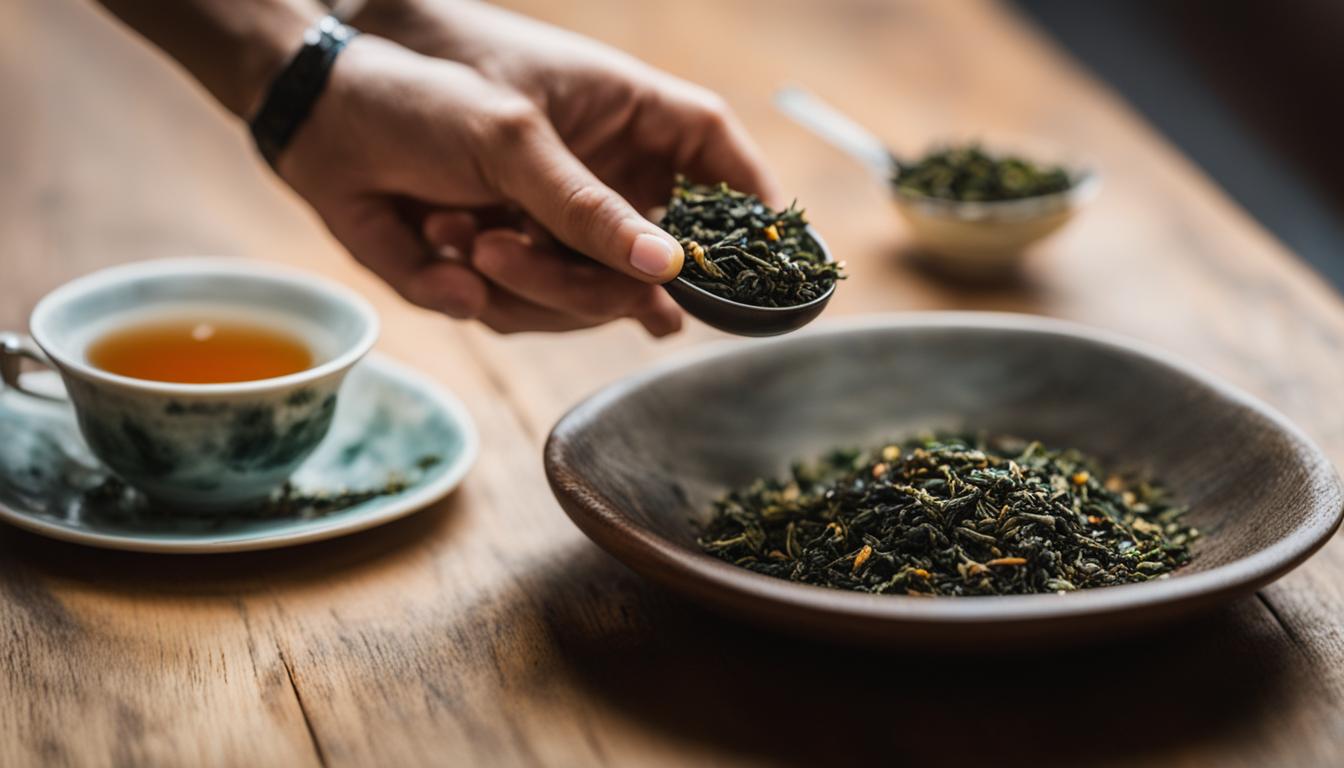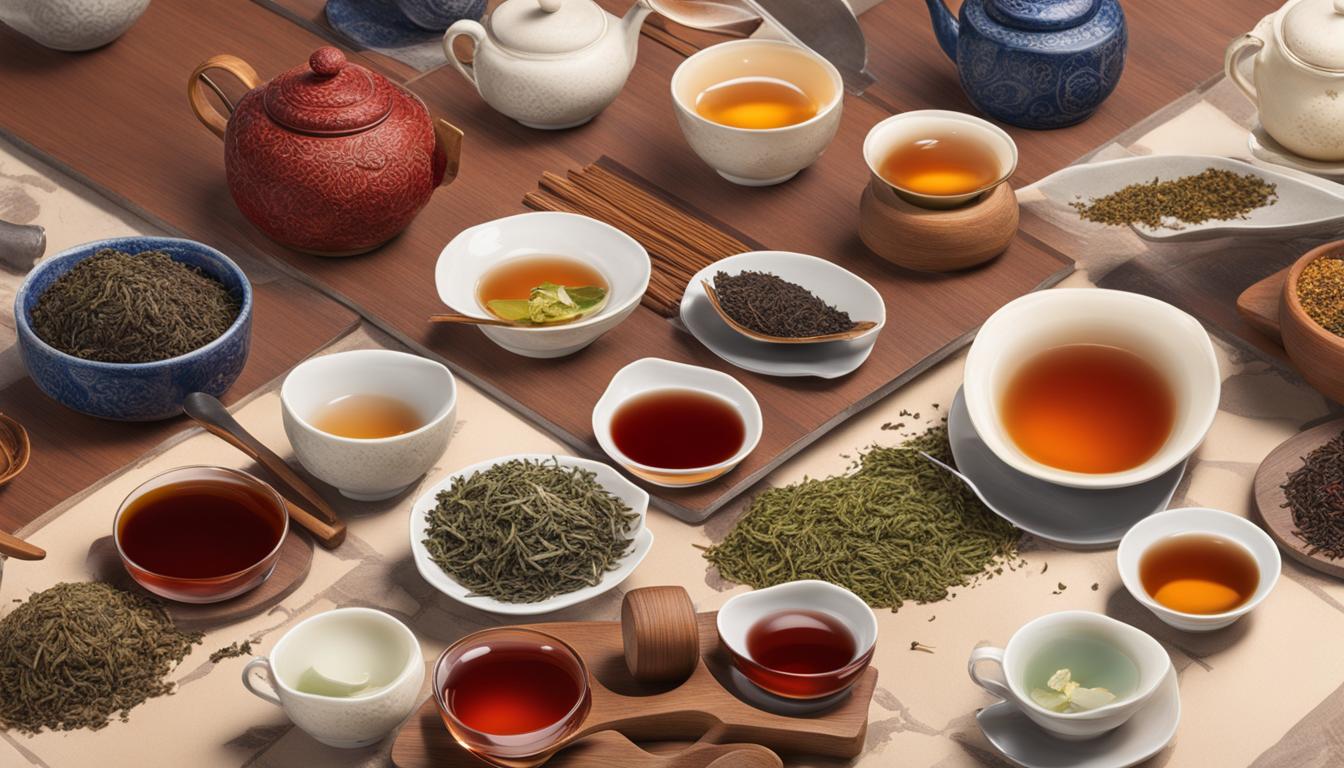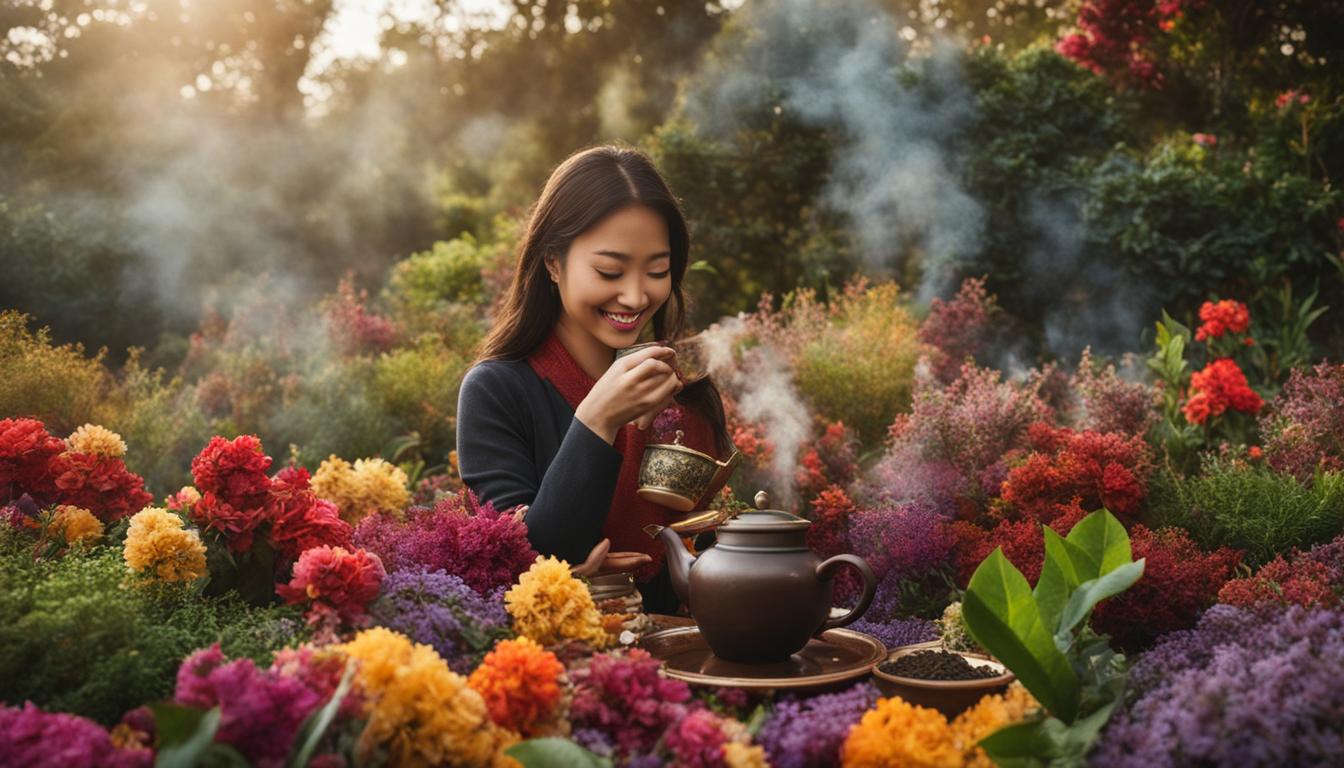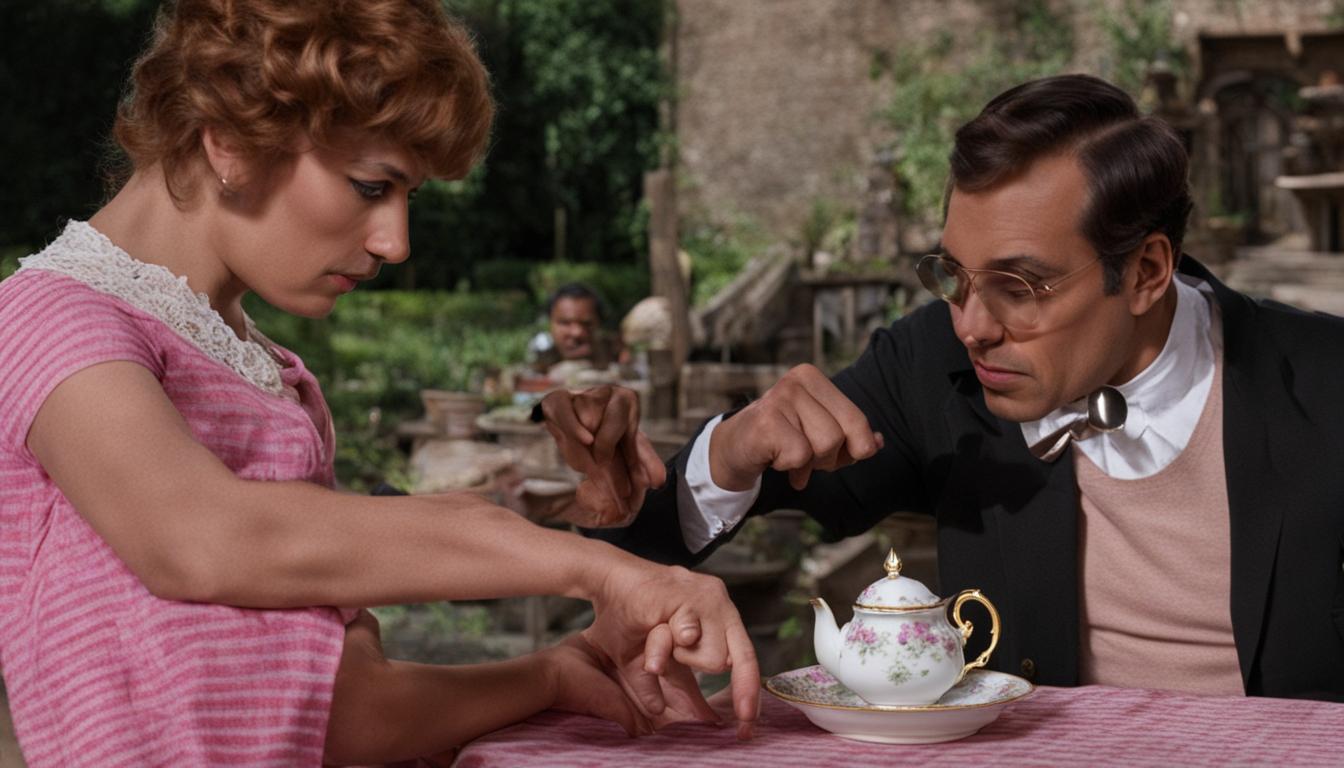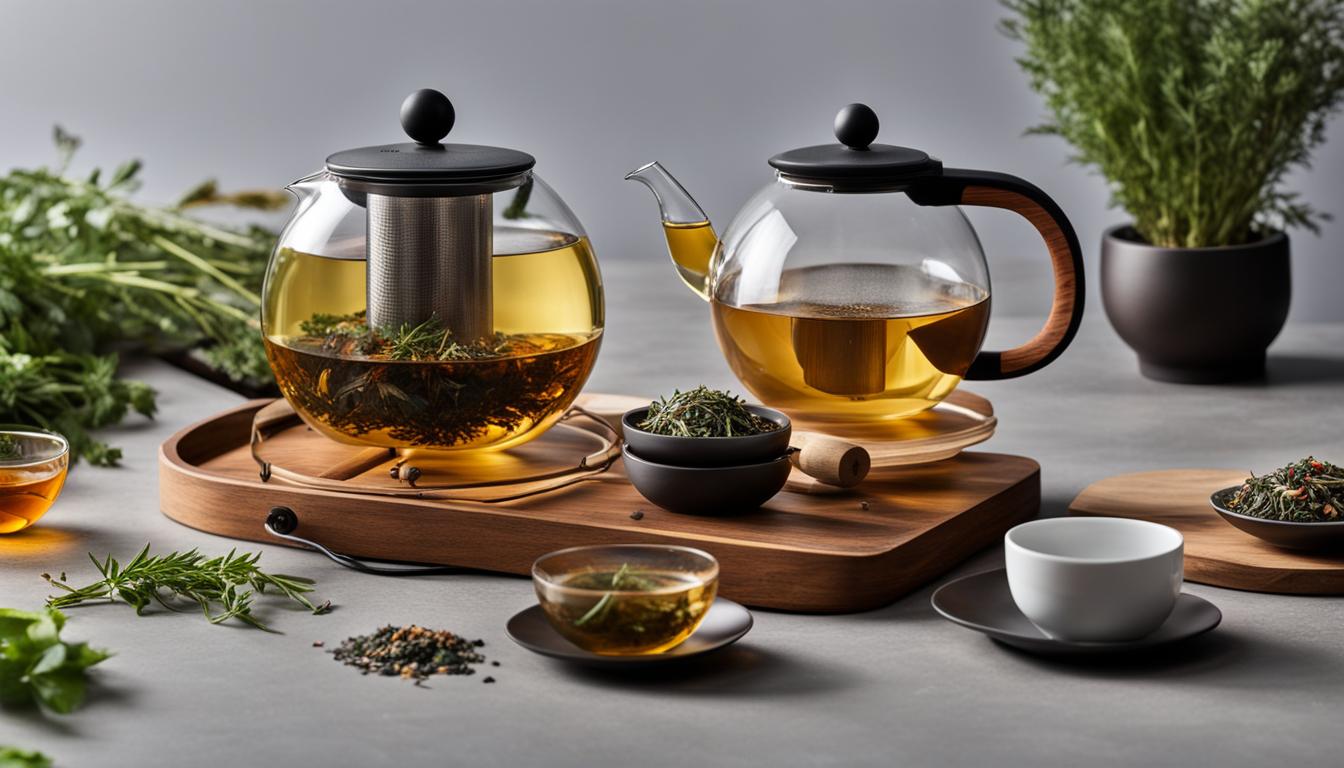Tea tasting is an art that requires years of training and practice to truly appreciate and understand the complex flavors and nuances of different teas. At its core, tea tasting is an exploration of the senses, where we rely on our keen sense of smell, taste, and sight to assess the quality and character of each tea. By embarking on this journey of mastering the art of tea tasting, we can enhance our senses, discover exquisite flavors, and become true tea connoisseurs.
Key Takeaways:
- Tea tasting is a complex art that requires years of training and practice.
- A tea taster must possess a keen sense of smell, taste, and sight to assess the quality of tea.
- The tea tasting process involves evaluating the appearance, aroma, taste, and overall experience of the tea.
- Participating in tea tasting workshops and seeking advanced tips can help improve one’s tea tasting technique.
- Becoming a tea taster requires knowledge of cultivation and manufacturing processes as well as staying informed about the tea market.
The Tea Tasting Process
Tea tasting is a sensory journey that involves analyzing the appearance, aroma, taste, and mouthfeel of the tea. This process requires a keen attention to detail and a refined palate. By understanding the tea tasting process, one can enhance their ability to analyze and appreciate the unique qualities of different teas.
Visual Assessment
Before even tasting the tea, a tea taster begins by visually assessing the dry tea leaves. They examine the color, size, and shape of the leaves, as well as any other unique characteristics. This visual assessment can provide insights into the quality and craftsmanship of the tea.
Aroma Evaluation
The aroma of the brewed tea is a crucial aspect of the tasting process. A tea taster takes a deep inhale to capture the fragrance and notes of the tea. This step allows them to assess the complexity, intensity, and overall quality of the tea’s aroma.
Taste Analysis
When it comes to tasting the tea, a tea taster follows a specific technique. They take a small sip and allow the tea to coat their palate. By slurping the tea, they aerate it, releasing more flavors and capturing the subtleties. The taster evaluates the taste profile, noting any dominant flavors, balance, and overall impression.
Mouthfeel Observation
The mouthfeel refers to the texture and sensation of the tea in the mouth. A tea taster pays attention to the body, viscosity, and how the tea lingers on the palate. They assess the mouthfeel to determine the completeness and overall quality of the tea.
| Tasting Step | Description |
|---|---|
| Visual Assessment | Examining the appearance of the dry tea leaves |
| Aroma Evaluation | Taking a deep inhale to assess the fragrance of the brewed tea |
| Taste Analysis | Evaluating the taste profile and noting dominant flavors |
| Mouthfeel Observation | Assessing the texture and sensation of the tea in the mouth |
Participating in a tea tasting workshop can provide valuable insights and advanced tips to improve one’s tea tasting technique. These workshops often cover topics such as identifying subtle flavor notes, understanding different tea varieties, and refining sensory skills. By honing their tea tasting abilities, enthusiasts can delve deeper into the world of tea and elevate their tea-drinking experience.
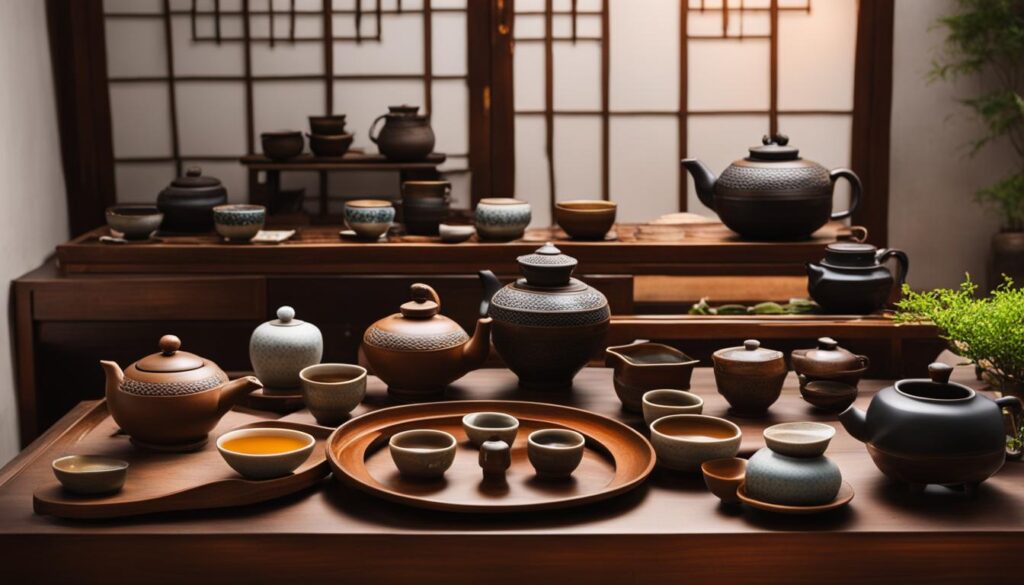
“Tea tasting is a sensory experience that requires attention to detail and an open mind. By immersing ourselves in the process, we can unlock the beauty and complexity of tea, discovering new flavors and expanding our palate.”
The Three “T’s” of Brewing Tea
When it comes to brewing tea, there are three key factors that must be considered to achieve the perfect cup: temperature, time, and teapot material. Each of these elements plays a crucial role in bringing out the optimal flavors and aromas of different types of tea.
Temperature
The temperature at which you brew your tea can greatly impact its taste. Different varieties of tea require specific temperature ranges to extract the best flavors. For delicate teas like green tea or white tea, lower temperatures around 160°F (70°C) are recommended to avoid oversteeping and bitterness. On the other hand, black teas and herbal infusions benefit from hotter water temperatures around 212°F (100°C) to extract their full-bodied flavors. It’s important to pay attention to temperature to ensure that each cup of tea turns out just right.
Time
The steeping or brewing time is another critical factor in tea preparation. The time that tea leaves are left to infuse in hot water determines the overall strength and flavor profile of the tea. Generally, green teas require shorter steeping times, ranging from 1-3 minutes, to avoid a bitter taste. Black teas, on the other hand, can be steeped for longer durations, usually around 3-5 minutes, to fully develop their robust flavors. It’s essential to follow the recommended steeping times for each type of tea to achieve the desired taste.
Teapot Material
The material of the teapot used for brewing tea can also have an impact on the final result. Different materials, such as ceramic, glass, and clay, have varying properties that affect heat retention and heat distribution. For example, ceramic teapots are known for their ability to retain heat and provide even heat distribution, making them suitable for a wide range of teas. Clay teapots, on the other hand, are often favored for their porous nature, which allows the teas to develop a unique aroma and taste. Choosing the right teapot material based on the type of tea being brewed is essential for a well-rounded and flavorful cup of tea.
By understanding and paying attention to these three “T’s” of brewing tea, you can elevate your tea-drinking experience and truly savor the flavors and aromas of each cup. Experiment with different temperatures, steeping times, and teapot materials to find your perfect brew. Remember, each type of tea is unique, and the journey of discovering the perfect cup is part of the joy of being a tea lover.
| Type of Tea | Recommended Brewing Temperature | Recommended Steeping Time |
|---|---|---|
| Green Tea | 160°F (70°C) | 1-3 minutes |
| Black Tea | 212°F (100°C) | 3-5 minutes |
| Oolong Tea | 190-200°F (87-93°C) | 2-4 minutes |
| White Tea | 160-180°F (70-82°C) | 2-3 minutes |
| Herbal Infusions | 212°F (100°C) | 5-7 minutes |
Becoming a Tea Taster
In order to become a tea taster, there are certain requirements and skills that one must possess. First and foremost, cultivating sensory organs is crucial. A tea taster needs to have a well-trained sense of smell to detect the subtle fragrances that different teas release. This allows them to accurately identify the unique aromas and characteristics of each tea.
Additionally, having knowledge of the tea market is essential. This includes understanding the cultivation and manufacturing processes, as well as being familiar with various tea kinds, varieties, grades, and resulting liquor characters. Staying informed about the tea market trends and being adaptable to changing market forces is crucial for success as a tea taster.
Furthermore, it is important for tea tasters to abstain from habits that may dull their senses. This includes avoiding smoking, alcohol consumption, and tasting strong, spicy foods, as these can interfere with the ability to accurately assess and appreciate the flavors of tea.
Cultivating Sensory Organs
Cultivating sensory organs is a fundamental part of becoming a tea taster. The sense of smell plays a significant role in identifying the different aromas that teas release. Regularly exposing yourself to various scents, such as flowers, herbs, and fruits, can help train your olfactory senses and enhance your ability to detect and differentiate the subtle aromas in teas.
Tea Market Knowledge
Having a strong understanding of the tea market is essential for a tea taster. This includes staying up to date with current trends, new tea varieties, and emerging tea regions. Reading industry publications, attending tea trade shows, and participating in tea tasting discussions can all help expand your knowledge and keep you informed about the latest developments in the tea market.
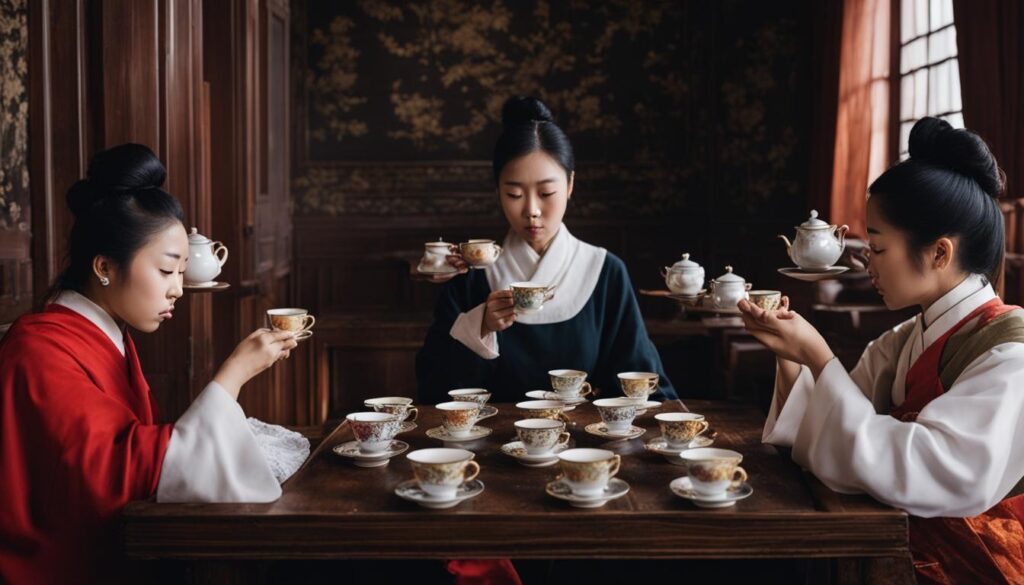
| Requirements | Skills and Qualifications |
|---|---|
| Well-trained sense of smell | Ability to detect and identify subtle aromas |
| Knowledge of tea cultivation and manufacturing processes | Understanding of tea kinds, varieties, and grades |
| Stay informed about the tea market trends | Adaptability to changing market forces |
| Avoid habits that may dull senses | No smoking, alcohol consumption, or strong, spicy foods |
Conclusion
Tea tasting is an art that we have explored in this article, and it requires expertise, practice, and a deep appreciation for the complexities of tea. By following the tea tasting techniques, tips, and guidelines we have shared, you can refine your tea tasting skills and elevate your tea-drinking experience.
Whether you attend a tea tasting workshop or practice at home, the journey to mastering the art of tea tasting is a delightful and rewarding one. With a better understanding of the tea tasting process and the ability to assess flavors, aromas, and characteristics, you can discover new favorite teas and truly indulge in the world of tea.
As you continue your tea tasting journey, remember to stay curious, experiment with different teas, and embrace the unique qualities each one offers. By developing your sensory organs and staying informed about the tea market, you can become a true tea aficionado.
Professional Tea Tasting Tips
Here are a few final tea tasting tips to keep in mind:
- Use a clean and neutral-tasting cup or teapot to avoid any interference with the flavors of the tea.
- Take your time when tasting, allowing the tea to linger on your palate and fully experience its taste and aroma.
- Take notes during your tea tasting sessions to record your impressions and keep track of teas you enjoy.
- Experiment with different brewing parameters, such as water temperature and steeping time, to bring out different flavors and nuances in the tea.
- Lastly, trust your own taste buds and preferences when evaluating teas. Everyone’s palate is unique, so don’t be afraid to trust your instincts.
We hope you enjoy your tea tasting adventures and discover endless enjoyment in the diverse world of tea!
FAQ
What is tea tasting?
Tea tasting is the process of assessing the quality, character, and flavors of different teas. It involves evaluating the appearance, aroma, taste, and overall experience of the tea.
What are the steps involved in tea tasting?
The tea tasting process includes visual assessment, aroma evaluation, taste analysis, and mouthfeel observation. It involves examining the appearance of the dry tea leaves, inhaling deeply to detect the aroma of the brewed tea, and evaluating the headnote, body note, and aftertaste while tasting the tea.
How can I improve my tea tasting technique?
Participating in a tea tasting workshop or seeking advanced tea tasting tips can help improve your tea tasting technique. It’s also beneficial to continue learning from others and engaging in tea tasting discussions.
What factors should I consider when brewing tea?
Three essential factors to consider when brewing tea are temperature, time, and teapot material. Each variety of tea requires a specific temperature range for optimal flavor extraction, and brewing time varies depending on the type of tea. The material of the teapot also impacts the quality of the brew.
What qualifications and skills do I need to become a tea taster?
To become a tea taster, you should possess a well-trained sense of smell, knowledge of cultivation and manufacturing processes, and an understanding of tea kinds, varieties, grades, and resulting liquor characters. It’s important to abstain from habits that may dull your senses and stay informed about the tea market.
How can I master the art of tea tasting?
By following tea tasting techniques, tips, and guidelines, you can refine your tea tasting skills and elevate your tea-drinking experience. Whether attending a tea tasting workshop or practicing at home, the journey to mastering the art of tea tasting is a delightful and rewarding one.

